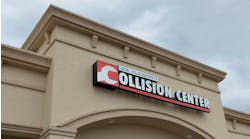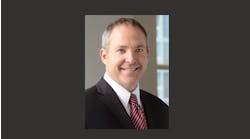If you were to create a prototypical 30-something collision repair shop operator, he or she would probably look something like this: second- or third-generation collision repairer. Grew up around the family shop. Attended college, typically with a business focus or degree. Has some technical certifications or is a highly certified technician. Is taking over day-to-day operations as the previous generation moves toward retirement.
That describes Barry Dorn to a T. Vice president of Dorn’s Body and Paint in Mechanicsville, Va., Dorn started sweeping floors at eight years old at his father’s shop. Some three decades later, he’s one of the up-and-coming collision repairers in the industry as he moves into managing the shop while also serving as chairman of the Society of Professional Collision Repairers. Dorn, 39, admits that, as much as cars are in his blood, it’s the business aspect of the shop that he really loves.
“This business intrigued me, as I think it does for a lot of the folks coming up through the ranks,” Dorn says. “I do like getting my hands dirty, but it’s the business aspect of it that I enjoy.”
As the collision industry evolves, so do the people who drive the business. FenderBender captured a snapshot of the collision repairer of the future, interviewing some rising-star shop owners under age 40 to find out how they’re running their shops and how they view the industry’s future.
Three things become clear:
#1. The people who’ve been saying that shop owners need to be more business-minded will be getting their wish. The new wave of young owners is passionate about the business aspect of running repair shops.
#2. The perception of the customer—who it is and what they want—is changing in some surprising ways among these young yet experienced new owners and operators.
And finally, #3. While times are undeniably tough in the industry, the young folks in the business are optimistic about the future and determined to make a place for themselves in it, even as the industry contracts and consolidates.
+ What Gen Y Wants
For customers under 35, their buying decisions are going to be impacted by the recession we’re going through right now—likely for the rest of their lives. It’s important for businesses to be sensitive to that when marketing to young people.
Focus on Business
When you talk to some of the younger shop operators in the business, it’s immediately clear they’re determined to follow the mantra: Work on your business, not in it. “We’re constantly changing, which I think is different from 10 or 20 years ago,” says Brett Bailey, 33, who owns five CARSTAR locations in the Kansas City, Mo., metro area. “Our business model is that every day, there’s change in the system or process. We’re always looking for the next best system to improve our quality of life.”
For Bailey, some of the changes he’s implemented in his shops include:
• Using smart scheduling to control the shop’s backlog of cars waiting for service. Ten years ago, some shops had a backlog of up to eight weeks, Bailey says. “In today’s day and age, you can’t do that. The customer will go somewhere else.” Still, you can’t completely eliminate backlog, because you need to have work available for the slow weeks and months. “There’s a happy medium there somewhere,” Bailey says.
• Using employees as the shop’s marketers. All of Bailey’s employees go through informal training on how to talk about the shop, even when they’re off the clock. They all have CARSTAR shirts and hats to wear, and all employees, including shop floor workers, have business cards. “If your employees take pride in their shop, and they wear your company logo out in public, they’ll talk to their friends and neighbors about the shop,” Bailey says. “It’s a great marketing tool.”
• Taking lean processes with a grain of salt. “If you have the right culture and employees, lean will occur naturally,” Bailey says. “You hear so many horror stories of people who go out and buy a book, and they come in to the shop and say, ‘Today, we’re going to start being a lean facility, and we’re going to change how you get paid.’ You can’t just dump it on people. For somebody who’s been in the shop 25 or 30 years, their gut feeling is still worth something, too.” And Bailey should know; the average tenure of his 91 employees is more than 12 years.
Who’s Your Customer?
As the industry evolves, the description of the typical collision repair customer gets complicated. Gone are the days when the only customer a repairer had to satisfy was the owner of the vehicle being repaired. Now, the term “customer” can mean an insurance carrier, a dealership or a company with a fleet of cars, not to mention the person who actually drives the car off the lot. The young people in the collision repair industry understand the complexity of the customer identity, and they’re adept at juggling all those customers’ needs—and sometimes even their simultaneous phone calls.
For Joe O’Connell, owner of Millis Collision Center in Millis, Mass., the question of whether to solicit insurance company referrals is moot. O’Connell, 39, has decided that partnering with insurance carriers is the way he wants to run his shop, because he sees the brightest future in that. So he’s relentless in pursuing new insurance partners, and he’s careful to do his best by the partners he already has. Yet, he knows that keeping car owners happy is the way to keep insurance partners happy. So O’Connell’s customer focus is wide-ranging and dynamic.
“I need to prove myself to these guys,” O’Connell says of the insurance companies in his state. “I want us to have a good reputation, so the insurance guys in town trust us.”
Unlike many collision repairers, O’Connell didn’t inherit his business; he started it from the ground up. That meant he had to start largely from scratch with insurance company relationships. And things are going well. His 3,500 square-foot shop gets 75 percent of its business from insurance referrals, and its 2010 gross sales are projected to be $850,000, up from $550,000 in 2009. He attributes that to his dual focus on quality of repairs and excellent customer service.
Here are a few of O’Connell’s strategies for keeping customers happy and building relationships with insurers:
• Giving his cell phone number to every customer. “My main focus is to keep everybody happy,” O’Connell says, adding that he knows of shops where managers “throw the keys back at customers and demand their money. I make sure to shake the hand of everyone who gets their car fixed here, and to give them one-on-one attention.”
• Asking customers to tell their insurance company if they’re happy with the quality and service at Millis Collision. “I ask them, ‘Hey, if you could just call your insurance agent and put in a good word for me and let them know about your experience here if you’re happy with it, that would be great,’” O’Connell says.
• Being persistent with insurance companies whose referral lists he isn’t on yet. O’Connell recalls how he got on one insurance company’s referral list: “It took a lot of persistent hounding and whining. We said, ‘Look, don’t overlook us. We’re small, but we’re doing good quality work in a small community.’ I kept making that same phone call over and over, and finally they sent someone down.”
+ What Gen Y Wants+ What Gen Y WantsAlmost every type of media young people are consuming now comes through the Internet, so it’s important for your marketing to come through those channels as well.
Being green or not being green isn’t what’s going to make it or break it with this generation. But being honest and transparent about your environmental efforts will.
Future of the Industry
No one’s disputing the numbers: the collision repair industry is shrinking and consolidating, while the number of car accidents is going down. For family-owned businesses like many of those being taken over by young repairers, it’s a time to think hard about identity and what the future holds.
Tori Mahnke, chief operating officer of Mahnke Auto Body in Arvada, Colo., says her four-shop company has made some moves already and is considering more to prepare for the future of a changing industry:
• Get ready to specialize. With the technical aspects of collision repair getting more complicated all the time, thanks to new metals and other technological advances, Mahnke says she thinks shops will start to specialize in certain brands. “We’re going to have to invest in equipment and training, so we’ll likely have to start specializing in order to make profits.”
• Band together. Mahnke Auto Body has joined Fix Auto Network, a network of 260 body shops that provides shops with assistance dealing with insurance companies, branding, customer service indexing and information gathering, among other services. “As a single shop, or a three-, four-, or five-location shop, you have no voice at all in the industry,” says Mahnke, 36. “You need to know what’s happening now rather than a month from now.”
• Stay nimble. With all the changes afoot in the industry, Mahnke says being open to new technology and new ways of doing things is imperative. “There are all these different DRP requirements, new EPA and OSHA requirements. There’s quite a bit of information, and we have to know how to deal with it all correctly.”
Ride It Out
Change is inevitable, but the young people coming up through the ranks in collision repair are up for the challenges that lie ahead. “The future’s bright. We’ve had our bumps and bruises,” says Dorn. “But then I put things into perspective: Our first four months of this year are the most profitable we’ve ever had. You have to make changes or you’re going to get passed by. We’ve made a lot of those changes.”
+ What Gen Y Wants+ What Gen Y Wants


